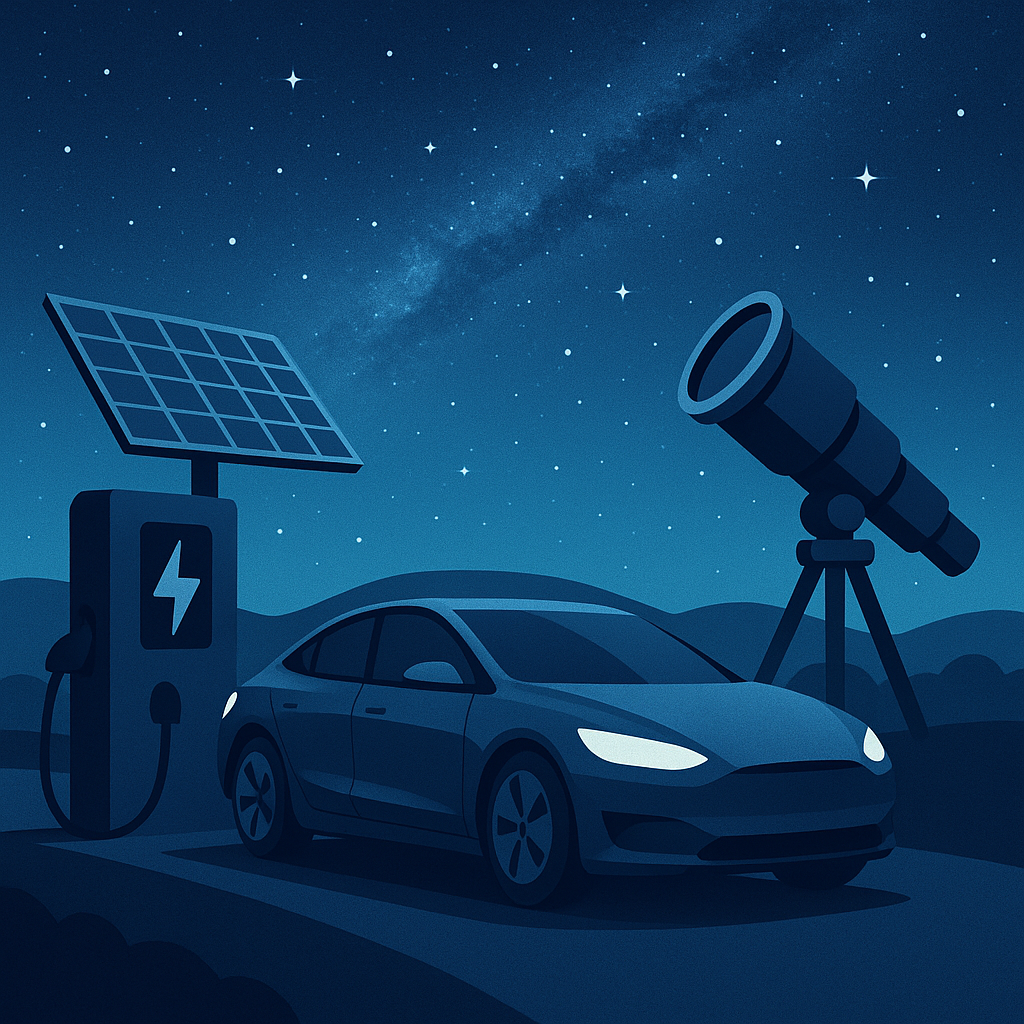🚗⚡ 별 보러 가는 길, 전기차로
전기차와 천문학? 얼핏 전혀 상관없는 것 같지만, 연결고리를 찾아보면 꽤 그럴듯하다.
먼저 전기차의 배터리와 천문학의 관측 장비는 공통점이 있다. 둘 다 에너지 효율이 생명이다. 배터리가 빨리 닳으면 도로 한복판에 멈추고, 관측 장비 전력이 끊기면 수천억짜리 연구가 ‘깜깜 모드’로 전환된다.
🔋 배터리와 태양광
전기차 충전소가 태양광 패널을 쓰는 경우가 늘고 있다. 천문학자들은 이미 수십 년 전부터 태양광을 관측 장비 전력으로 활용해왔다. 태양은 전기차의 연료이자, 망원경의 연구 대상이라는 점에서 묘하게 겹친다. 즉, 둘 다 태양을 ‘먹고 사는’ 직업(?)이다.
🌌 자율주행과 천체추적
전기차의 자율주행 센서는 카메라와 레이더, 라이다를 조합해 주변 환경을 인식한다. 천문학의 자동 추적 시스템도 마찬가지다. 별을 쫓아가는 천체 추적기는, 밤하늘 버전의 자율주행이다. 둘 다 정확한 위치 계산과 실시간 데이터 처리가 필수다.
🌍 탄소 감축과 지구 보호
전기차는 배기가스를 줄이고, 천문학은 지구의 기후 변화를 우주적 시각에서 분석한다. 예를 들어 위성 관측은 대기 중 이산화탄소 농도와 오존층 변화를 측정한다. 전기차와 천문학이 궁극적으로 향하는 목표는 같다 — 지구를 오래 쓰자.
🔭 기술 교차점: 소재와 센서
전기차의 경량화에 쓰이는 탄소섬유, 알루미늄 합금은 대형 망원경의 구조에도 사용된다. 진동을 줄이는 서스펜션 기술은 위성의 안정화 시스템에도 응용된다. 심지어 전기차의 고해상도 카메라 모듈이 별 관측 카메라와 유사한 원리로 작동하기도 한다. 즉, 도로 위와 우주 연구실이 같은 기술 언어를 쓰는 셈이다.
🚀 미래: 전기차가 우주 관측 도우미가 될까?
미래에는 전기차의 대용량 배터리가 이동식 관측 장비 전원으로 쓰일 수 있다. 전기차가 관측소까지 장비를 실어 나르고, 현장에서 전력을 공급하는 ‘이동형 파워뱅크’ 역할을 하는 것이다. 태양광 충전소와 전기차, 그리고 망원경이 연결된다면, 별을 보기 위해 발전기를 돌릴 필요가 없는 시대가 올 수 있다.
🤣 마무리 농담
만약 천문학자가 전기차를 몰고 관측소에 간다면, 별을 보러 가는 길이 이미 우주 탐사의 일부가 될지도 모른다. 별빛을 보며 달리는 전기차, 충전은 태양으로, 내비게이션은 은하수를 따라. 이쯤 되면 ‘전기차’가 아니라 ‘소형 우주선’이라고 불러도 되지 않을까.
음소분석 코너
1. Carbon Reduction
• 뜻:
• carbon — 탄소
• reduction — 감소, 축소, 절감
→ Carbon Reduction: 탄소 감축, 탄소 배출량 줄이기
• 발음기호: /ˈkɑːr.bən rɪˈdʌk.ʃən/
• 액센트(강세):
• carbon → 첫 음절 **ˈcar-**에 강세
• reduction → 두 번째 음절 **-ˈduc-**에 강세
• 발음 팁:
• **car-**에서 /kɑːr/는 ‘카~르’처럼 길게, r 발음 시 혀끝을 살짝 말아 올림
• -bon은 /bən/으로 슈와(ə) 발음, 약하게 “번”
• reduction에서 **re-**는 약하게 /rɪ/, -duction의 /ˈdʌk/ 부분을 확실히 강하게
• 마지막 -tion은 /ʃən/, ‘션’처럼 부드럽게 연결
• 음소분석:
carbon → /k/ [k], /ɑː/ [aː], /r/ [r], /b/ [b], /ən/ [ən]
reduction → /r/ [r], /ɪ/ [ɪ], /d/ [d], /ʌ/ [ʌ], /k/ [k], /ʃ/ [ʃ], /ən/ [ən]
2. aluminum (미국식)
• 뜻: 알루미늄 (금속 원소)
• 발음기호(미국식): /əˈluː.mə.nəm/
• 액센트(강세): 두 번째 음절 **-ˈlu-**에 강세
• 발음 팁:
• 첫 음절 **a-**는 /ə/, ‘어’처럼 약하게 시작
• **-lu-**에서 /luː/는 길게 ‘루~’ 발음
• **-mi-**는 /mə/로 매우 약하게 발음
• 마지막 -num은 /nəm/ ‘넘’처럼 짧고 부드럽게 끝냄
• 음소분석:
/ə/ [ə] 슈와, /l/ [l] 혀끝 윗잇몸, /uː/ [uː] 길게, /m/ [m] 양순 비음, /ə/ [ə], /n/ [n], /əm/ [
📌 발음 트레이닝 문장
문장:
The Carbon Reduction plan uses lightweight aluminum frames.
(탄소 감축 계획은 가벼운 알루미늄 프레임을 사용한다.)
🎯 강세·길이·연음 표기
/ðə ˈkɑːr.bən rɪˈdʌk.ʃən plæn ˈjuː.zɪz ˈlaɪt.weɪt əˈluː.mə.nəm freɪmz/
• 강세: 굵게 표시한 음절에 강세 (ˈ 기호 있는 부분)
• 길이: 모음 길이는 굵게 + 모음 기호로 표기 (예: /ɑː/, /uː/)
• 연음:
• Reduction plan → /n pl/ 부분에서 ‘n’과 ‘pl’이 부드럽게 연결
• lightweight aluminum → /t ə/ 부분이 ‘t’ 발음 후 바로 ‘어’로 넘어감
🗣 발음 팁 & 리듬
1. Carbon → CAR를 길고 세게, bon은 짧고 약하게
2. Reduction → re-는 약하게, DUC에서 짧지만 확실히 세게, tion은 ‘션’
3. aluminum → 첫 a-는 가볍게 ‘어’, LU를 길게, mi-는 ‘머’, num은 ‘넘’
4. 문장 전체는 강-약-강-약 리듬으로, 강세 있는 단어에 살짝 더 힘을 줌
5. Carbon Reduction plan → 하나의 덩어리처럼 부드럽게 연결

🚗⚡ Driving to the Stars… in an EV
Electric cars and astronomy? At first glance, they seem worlds apart, but the connections are surprisingly clear. Both rely heavily on energy efficiency. If an EV’s battery runs out, you’re stranded on the road. If a telescope’s power cuts off, multi-million-dollar research goes dark in an instant.
🔋 Batteries and the Sun
Solar-powered charging stations for EVs are becoming more common. Astronomers, however, have been using solar energy to power observatories for decades. The Sun is both a fuel source for EVs and a research subject for telescopes — making it the boss of both industries.
🌌 Autonomous Driving and Star Tracking
An EV’s self-driving system uses cameras, radar, and LiDAR to map its surroundings. Astronomy’s auto-tracking systems do something similar — they follow stars across the sky with extreme precision. Both require accurate positioning and real-time data processing.
🌍 Carbon Reduction and Planet Protection
EVs cut down emissions, while astronomy provides a cosmic perspective on Earth’s climate change. Satellites monitor CO₂ levels and ozone changes, helping us understand how to protect our home planet. In the end, both EVs and astronomy share the same mission: make Earth last longer.
🔭 Shared Technology: Materials and Sensors
Lightweight carbon fiber and aluminum alloys used in EVs also support giant telescope structures. Vibration-reducing suspension systems inspire satellite stabilization tech. Even high-resolution EV cameras work on similar principles as astronomical imaging devices. The road and the observatory speak the same tech language.
🚀 The Future: EVs as Astronomy Assistants
One day, EVs’ massive batteries could power portable observatories. Imagine an EV hauling equipment to a remote site, then acting as a “mobile power bank” for the night’s observations. Solar charging stations, EVs, and telescopes could form a clean-energy stargazing network — no noisy diesel generators required.
🤣 A Light-Hearted Ending
If an astronomer drives an EV to an observatory, the journey itself might feel like part of the space mission. Charging from the Sun, navigating by the Milky Way, and gazing at the stars — at that point, it’s less of an “electric car” and more of a mini spaceship.
#전기차 #천문학 #전기차와천문학 #태양광충전 #자율주행 #천체추적 #탄소감축 #지구보호 #미래기술 #우주유머